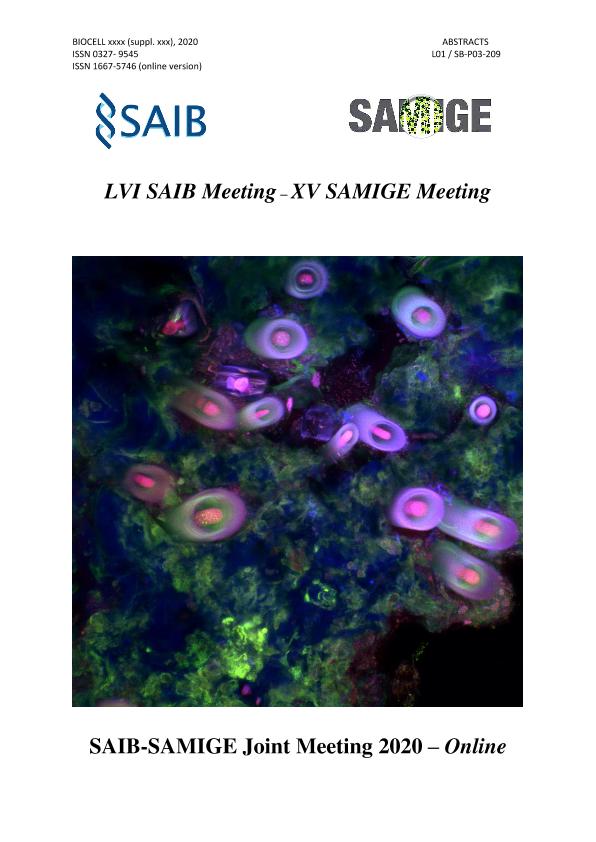Mostrar el registro sencillo del ítem
dc.contributor.author
Peralta, Maria Patricia

dc.contributor.author
Delgado, Osvaldo Daniel

dc.contributor.author
Lechner, Bernardo Ernesto

dc.contributor.author
Fariña, Julia Ines

dc.date.available
2022-12-15T14:10:46Z
dc.date.issued
2020
dc.identifier.citation
Optimization of pH for L-Dopa production in bench-top scale stirred-tank bioreactor using a Paraboeremia strain; LVI Annual Meeting Argentine Society for Biochemistry and Molecular Biology and XV Annual Meeting Argentinean Society for General Microbiology; Ciudad Autónoma de Buenos Aires; Argentina; 2020; 1-6
dc.identifier.uri
http://hdl.handle.net/11336/181321
dc.description.abstract
Biosimilars contain active molecules from a biological source, have the same biological function but come from a manufacturing process which differs from the traditional chemical production synthesis of the original drug, their active principles are usually more complex than those of the chemically synthesized counterparts, and only living organisms can reproduce this complexity. Parkinson is a disease associated with dopamine deficiency and levodopa has been the elected drug to treat it for decades. In recent years, various advances have allowed understanding the mechanisms of action. With chemically synthesized levodopa, patients develop motor complications manifested by the decrease in duration effect, which could be avoided with the use of microbiologically synthesized L-Dopa. The objective of this work was to study the influence of initial pH in the L-Dopa microbiological production process, by means of the operation of a bench-top bioreactor, using the selected fungus Paraboeremia LY 38.7, isolated from Las Yungas Tucumanas. For the production of L-Dopa at bioreactor scale and to study the effect of initial pH, previously optimized conditions at smaller scale were used as starting point. Accordingly, the initial pH was varied between 5.0 and 7.5, keeping constant further operative conditions for 5 days, i.e. aeration (1 vvm), temperature (25 ° C) and stirring rate (200 rpm), and sampling twice a day. Production of L-Dopa and L-Tyrosine consumption were measured by means of the Arnow method, tyrosinase monophenolase and diphenolase activities according to the dopachrome method, biomass by dry weight estimation and pH with a pHmeter. Results showed that volumetric productivity of L-Dopa was higher at pH 7 and 7.5 (4,11 mg?L-1?h-1 and 3,65 mg?L-1?h-1 respectively). These optimal pH values represented favourable conditions from the operational point of view, taking into account that recently prepared culture medium has a pH of 7.5. Additionally, it is also convenient in terms of productivity, since maximal L-Dopa production is achieved one day earlier (48 instead of 72 h) than at pH 5.0, 5.5, 6.0 and 6.5, which implies lower operating costs and adds more economic and industrial attractiveness.
dc.format
application/pdf
dc.language.iso
eng
dc.publisher
Tech Science Press

dc.rights
info:eu-repo/semantics/openAccess
dc.rights.uri
https://creativecommons.org/licenses/by-nc-sa/2.5/ar/
dc.subject
PARABOEREMIA
dc.subject
PH
dc.subject
BIORREACTOR
dc.subject
TIROSINASA-L-DOPA
dc.subject.classification
Bioprocesamiento Tecnológico, Biocatálisis, Fermentación

dc.subject.classification
Biotecnología Industrial

dc.subject.classification
INGENIERÍAS Y TECNOLOGÍAS

dc.title
Optimization of pH for L-Dopa production in bench-top scale stirred-tank bioreactor using a Paraboeremia strain
dc.type
info:eu-repo/semantics/publishedVersion
dc.type
info:eu-repo/semantics/conferenceObject
dc.type
info:ar-repo/semantics/documento de conferencia
dc.date.updated
2022-12-12T23:15:32Z
dc.journal.pagination
1-6
dc.journal.pais
Argentina

dc.journal.ciudad
Ciudad Autónoma de Buenos Aires
dc.description.fil
Fil: Peralta, Maria Patricia. Consejo Nacional de Investigaciones Científicas y Técnicas. Centro Científico Tecnológico Conicet - Tucumán. Planta Piloto de Procesos Industriales Microbiológicos; Argentina
dc.description.fil
Fil: Delgado, Osvaldo Daniel. Consejo Nacional de Investigaciones Científicas y Técnicas. Centro Científico Tecnológico Conicet - Tucumán. Planta Piloto de Procesos Industriales Microbiológicos; Argentina
dc.description.fil
Fil: Lechner, Bernardo Ernesto. Consejo Nacional de Investigaciones Científicas y Técnicas. Oficina de Coordinación Administrativa Ciudad Universitaria. Instituto de Micología y Botánica. Universidad de Buenos Aires. Facultad de Ciencias Exactas y Naturales. Instituto de Micología y Botánica; Argentina
dc.description.fil
Fil: Fariña, Julia Ines. Consejo Nacional de Investigaciones Científicas y Técnicas. Centro Científico Tecnológico Conicet - Tucumán. Planta Piloto de Procesos Industriales Microbiológicos; Argentina
dc.relation.alternativeid
info:eu-repo/semantics/altIdentifier/url/http://www.samige.org.ar/admin/news/files/170-TSP_BIOCELL_42376.pdf
dc.conicet.rol
Autor

dc.conicet.rol
Autor

dc.conicet.rol
Autor

dc.conicet.rol
Autor

dc.coverage
Internacional
dc.type.subtype
Reunión
dc.description.nombreEvento
LVI Annual Meeting Argentine Society for Biochemistry and Molecular Biology and XV Annual Meeting Argentinean Society for General Microbiology
dc.date.evento
2020-11
dc.description.ciudadEvento
Ciudad Autónoma de Buenos Aires
dc.description.paisEvento
Argentina

dc.type.publicacion
Journal
dc.description.institucionOrganizadora
Sociedad Argentina de Investigación Bioquímica y Biología Molecular
dc.description.institucionOrganizadora
Sociedad Argentina de Microbiología General
dc.source.revista
Biocell

dc.type
Reunión
Archivos asociados
